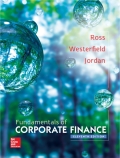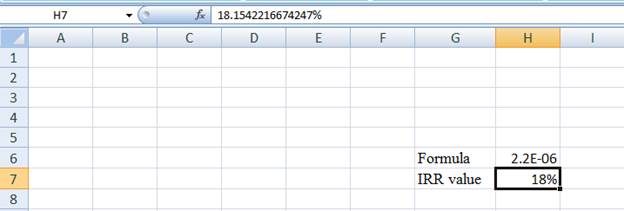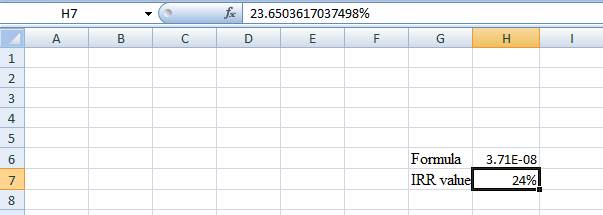
Concept explainers
Comparing Investment Criteria [LO1, 2, 3, 5, 7] Consider the following two mutually exclusive projects:
| Year | Cash Flow (A) | Cash Flow (B) |
| 0 | −$455,000 | −$65,000 |
| 1 | 58,000 | 31,000 |
| 2 | 85,000 | 28,000 |
| 3 | 85,000 | 25,500 |
| 4 | 572,000 | 19,000 |
Whichever project you choose, if any, you require a return of 11 percent on your investment
a. If you apply the payback criterion, which investment will you choose? Why?
b. If you apply the discounted payback criterion, which investment will you choose? Why?
c. If you apply the
d. If you apply the
e. If you apply the profitability index criterion, which investment will you choose? Why?
f. Based on your answers in (a) through (e), which project will you finally choose? Why?
a)
To compute: The payback period.
Introduction:
Capital budgeting is a process, where the business identifies and assesses the potential investments or expenses that are larger in general.
Answer to Problem 17QP
Here, Project B must be accepted as it pays back sooner than Project A.
Explanation of Solution
Given information:
The cash flows for two mutually exclusive projects are $58,000, $85,000, $85,000, $572,000 for Project A respectively for year 1, year 2, year 3, and year 4. Project A has an initial investment of $455,000. The cash flows of Project B are $31,000, $28,000, $25,500, and $19,000 respectively for year 1, year 2, year 3, and year 4. The initial investment for Project B is $65,000. The rate of return is 11%.
Formula to compute the payback period of a project:
Compute the payback period of a project for Project A:
Hence, the payback period is 3.40 years for Project A.
Compute the payback period of a project for Project B:
Hence, the payback period is 2.24 years for Project B.
b)
To compute: The discounted payback period.
Introduction:
Capital budgeting is a process, where the business identifies and assesses the potential investments or expenses that are larger in general.
Answer to Problem 17QP
Here, Project B must be accepted as it pays back sooner than Project A.
Explanation of Solution
Given information:
The cash flows for two mutually exclusive projects are $58,000, $85,000, $85,000, $572,000 for Project A respectively for year 1, year 2, year 3, and year 4. Project A has an initial investment of $455,000. The cash flows of Project B are $31,000, $28,000, $25,500, and $19,000 respectively for year 1, year 2, year 3, and year 4. The initial investment for Project B is $65,000. The rate of return is 11%.
Table showing the calculation of discounted payback period for Project A:
| Year | Net Cash Inflows | ||
| Annual | Today’s value (discounted) at 11% | Accumulated | |
| 1 | $58,000 | $52,252.25
| $52,252.25 |
| 2 | $85,000 | $68,987.91
| $121,240.16 |
| 3 | $85,000 | $62,151.27
| $183,391.43 |
| 4 | $572,000 | $376,794.12
| $560,185.55 |
Formula to compute the discounted payback period:
By the end of the year 3, the recovery amount is shorter than the initial investment. In the year 4, the recovery amount is higher than initial investment. It means the discounted payback period will be in between the year 3 and 4.
Calculate discounted payback period, if initial cost is $455,000:
Hence, the discounted payback period for Project A is 3.72 years.
Table showing the calculation of discounted payback period for Project B:
| Year | Net Cash Inflows | ||
| Annual | Today’s value (discounted) at 11% | Accumulated | |
| 1 | $31,000 | $27,927.93
| $27,927.93 |
| 2 | $28,000 | $22,725.43
| $50,653.36 |
| 3 | $25,500 | $18,645.38
| $69,298.74 |
| 4 | $19,000 | $12,515.89
| $81,814.63 |
Formula to calculate the discounted payback period for Project B, if initial cost is $65,000:
By the end of the year 2, the recovery amount is shorter than the initial investment. In the year 3, the recovery amount is higher than initial investment. It means the discounted payback period will be in between the year 2 and 3.
Calculate the discounted payback period for Project B, if initial cost is $65,000:
Hence, the discounted payback period for Project B is 2.77 years.
c)
To compute: The NPV (Net present value).
Introduction:
Capital budgeting is a process, where the business identifies and assesses the potential investments or expenses that are larger in general.
Answer to Problem 17QP
Here, Project A must be accepted as the NPV is higher in Project A.
Explanation of Solution
Given information:
The cash flows for two mutually exclusive projects are $58,000, $85,000, $85,000, $572,000 for Project A respectively for year 1, year 2, year 3, and year 4. Project A has an initial investment of $455,000. The cash flows of Project B are $31,000, $28,000, $25,500, and $19,000 respectively for year 1, year 2, year 3, and year 4. The initial investment for Project B is $65,000. The rate of return is 11%.
Formula to calculate the NPV:
Calculate the NPV for Project A:
Hence, the NPV for Project A is $105,185.54.
Calculate the NPV for Project B:
Hence, the NPV for Project B is $16,814.63.
d)
To compute: The IRR for the project.
Introduction:
Capital budgeting is a process, where the business identifies and assesses the potential investments or expenses that are larger in general.
Answer to Problem 17QP
Here, Project B must be accepted as the IRR is higher in Project B.
Explanation of Solution
Given information:
The cash flows for two mutually exclusive projects are $58,000, $85,000, $85,000, $572,000 for Project A respectively for year 1, year 2, year 3, and year 4. Project A has an initial investment of $455,000. The cash flows of Project B are $31,000, $28,000, $25,500, and $19,000 respectively for year 1, year 2, year 3, and year 4. The initial investment for Project B is $65,000. The rate of return is 11%.
Equation of IRR of Project A:
Compute IRR for Project A using a spreadsheet:
Step 1:

- Type the equation of NPV in H6 in the spreadsheet and consider the IRR value as H7
Step 2:

- Assume the IRR value as 10%
Step 3:

- In the spreadsheet go to data and select the what-if analysis
- In what-if analysis select goal seek
- In set cell select H6 (the Formula)
- The “To value” is considered as 0 (the assumption value for NPV)
- The H7 cell is selected for the by changing cell
Step 4:

- Following the previous step click OK in the goal seek. The goal seek status appears with the IRR value
Step 5:

- Thevalue appears to be 18.1542216674247%
Hence, the IRRvalue is 18.15%.
Equation of IRR of Project B:
Compute IRR for Project B using a spreadsheet:
Step 1:

- Type the equation of NPV in H6 in the spreadsheet and consider the IRR value as H7
Step 2:

- Assume the IRR value as 10%
Step 3:

- In the spreadsheet go to data and select the what-if analysis
- In what-if analysis select goal seek
- In set cell select H6 (the Formula)
- The “To value” is considered as 0 (the assumption value for NPV)
- The H7 cell is selected for the by changing cell
Step 4:

- Following the previous step click OK in the goal seek. The goal seek status appears with the IRR value
Step 5:

- Thevalue appears to be 23.6503617037489%
Hence, the IRRvalue is 23.65%.
e)
To compute: The profitability index.
Introduction:
Capital budgeting is a process, where the business identifies and assesses the potential investments or expenses that are larger in general.
Answer to Problem 17QP
Here, Project B must be accepted as the PI is higher in Project B.
Explanation of Solution
Given information:
The cash flows for two mutually exclusive projects are $58,000, $85,000, $85,000, $572,000 for Project A respectively for year 1, year 2, year 3, and year 4. Project A has an initial investment of $455,000. The cash flows of Project B are $31,000, $28,000, $25,500, and $19,000 respectively for year 1, year 2, year 3, and year 4. The initial investment for Project B is $65,000. The rate of return is 11%.
Formula to compute the profitability index:
Compute the profitability index for Project A:
Hence, the profitability index for Project A is $1.23.
Compute the profitability index for Project B:
Hence, the profitability index for Project B is $1.26.
f)
To discuss: The project that Person X will select with a reason.
Introduction:
Capital budgeting is a process, where the business identifies and assesses the potential investments or expenses that are larger in general.
Explanation of Solution
Given information:
The cash flows for two mutually exclusive projects are $58,000, $85,000, $85,000, $572,000 for Project A respectively for year 1, year 2, year 3, and year 4. Project A has an initial investment of $455,000. The cash flows of Project B are $31,000, $28,000, $25,500, and $19,000 respectively for year 1, year 2, year 3, and year 4. The initial investment for Project B is $65,000. The rate of return is 11%.
Explanation:
In this case, the criteria of NPV denote that Project A must be accepted, while payback period, discounted payback, profitability index, and IRR denote that Project B must be accepted. The overall decision must be based on the NPV as it does not have the ranking problem when compared with the other techniques of capital budgeting. Hence, Project A must be accepted.
Want to see more full solutions like this?
Chapter 9 Solutions
Fundamentals of Corporate Finance
- Don't use chatgpt!! 1. What does the term “liquidity” refer to in finance?A) Profitability of a companyB) The ease of converting assets into cashC) The amount of debt a firm hasD) The tax rate on investmentsarrow_forward3. A higher beta in the Capital Asset Pricing Model (CAPM) indicates:A. Lower volatility compared to the marketB. Higher volatility compared to the marketC. Guaranteed returnsD. Lower expected returnarrow_forwardDon't use chatgpt!! Diversification helps reduce:A. Systematic riskB. All financial risksC. Unsystematic riskD. Liquidity riskarrow_forward
- Don't use chatgpt!! The net present value (NPV) of a project is:A. The total profit of the projectB. The sum of all cash flowsC. The difference between present value of inflows and outflowsD. Equal to internal rate of returnarrow_forwardIf net income is $25,000 and total equity is $125,000, what is the return on equity (ROE)?A. 10%B. 15%C. 20%D. 25%arrow_forwardDon't use chatgpt! help in this question. Which of these is not a money market instrument?A. Treasury billB. Certificate of depositC. Commercial paperD. Corporate bondarrow_forward
- I need help ! no ai Which of these is not a money market instrument?A. Treasury billB. Certificate of depositC. Commercial paperD. Corporate bondarrow_forwardNo chatgpt! Which of these is not a money market instrument?A. Treasury billB. Certificate of depositC. Commercial paperD. Corporate bondarrow_forwardDont use Chatgpt! Which of these is not a money market instrument?A. Treasury billB. Certificate of depositC. Commercial paperD. Corporate bondarrow_forward
- I need help step by step with correct values.arrow_forwardNo AI What does the price-to-earnings (P/E) ratio measure?A. Company’s dividend yieldB. Value of assets per shareC. Market price relative to earnings per shareD. Return on equityarrow_forwarddon't use AI Which of the following is a primary market activity?A. Buying shares from another investorB. Selling bonds on a stock exchangeC. A company issuing new stock to the publicD. Trading derivatives on a futures exchangearrow_forward

 Intermediate Financial Management (MindTap Course...FinanceISBN:9781337395083Author:Eugene F. Brigham, Phillip R. DavesPublisher:Cengage Learning
Intermediate Financial Management (MindTap Course...FinanceISBN:9781337395083Author:Eugene F. Brigham, Phillip R. DavesPublisher:Cengage Learning EBK CONTEMPORARY FINANCIAL MANAGEMENTFinanceISBN:9781337514835Author:MOYERPublisher:CENGAGE LEARNING - CONSIGNMENT
EBK CONTEMPORARY FINANCIAL MANAGEMENTFinanceISBN:9781337514835Author:MOYERPublisher:CENGAGE LEARNING - CONSIGNMENT



